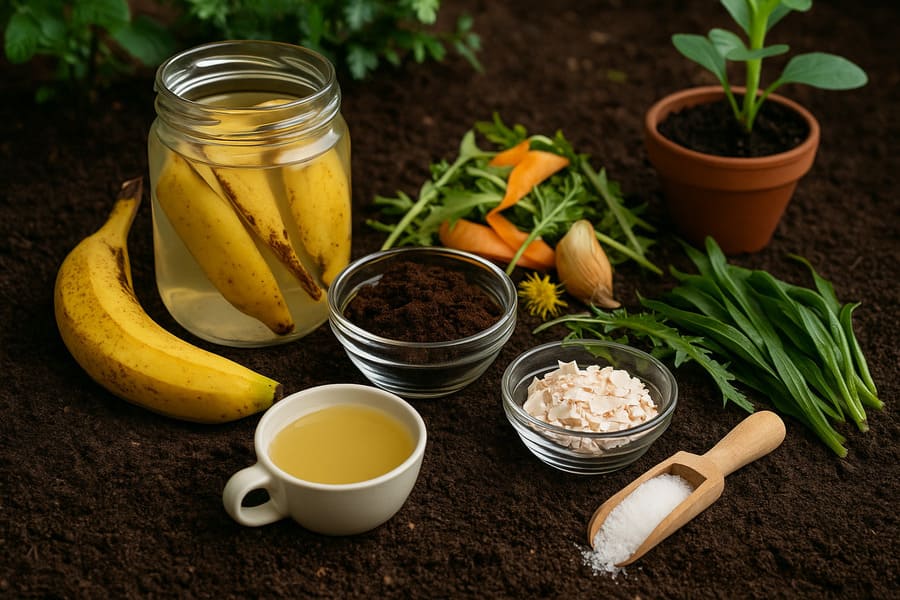Homemade fertilizers are a practical and environmentally friendly way to stimulate plant growth without the use of chemicals. You can use kitchen scraps and household waste to provide plants with loaded nutrients while eliminating waste and saving money.
This guide will look at 11 homemade fertilizers, from banana peels to weed tea, that you can make at home. Each option will include some suggestions and how-to options to get the most out of these organic plant food choices.
11 Homemade Fertilizers You Must Try Today

1 – Banana Peels
Banana peel is waste, but it has a lot of potassium, and potassium helps with flower and fruit production. In plants, potassium is responsible in part for water management, flowers and flower characteristics, and disease resistance. So save your banana peels as fertilizer. Several plant processes involve potassium including maintaining water regulation, producing flowers and flower attributes, and fighting disease, therefore, it’s useful to save banana peels to use for fertilizer.
- Method # 1 – Tear or cut the peels into small bits and bury them a few inches deep around the root zone of the plant. As they decompose, the potassium will gradually be released in to the soil.
- Method # 2 – Put several banana peels in a jar with water and let it sit for a few days. The water will become infused with potassium and nutrients and so you can dilute it with fresh water and use this once a week to water the plants.
2 – Coffee Grounds
Used coffee grounds can enhance soil structure and provide nutrition, particularly nitrogen and organic matter. They are slightly acidic when fresh but brewed coffee grounds are close to neutral, so in just a little bit they will not noticeably affect soil pH levels.
To make the best use of coffee grounds, sprinkle used coffee grounds lightly around acid loving landscape plants like azalea, blueberry and ferns. The coffee grounds will break down continuing to provide nitrogen and carbon for the soil, and the carbon and nitrogen provide food for soil organisms.
Gardening hack: For container plants, mix used coffee grounds into a potting mix.
3 – Egg Shells
As they decompose, eggshells are useful at enhancing soil structure and crushed yield food for soil creatures. Here are some possible uses for egg shells:
- Firstly, take out egg whites from the eggs and wash the egg shells.
- Then crush eggshells into small pieces. The smaller you grind or crush it all, the faster it will decompose in the soil.
- Mix into planting holes.
- Soak shells in water for 4–5 days, then water plants with the calcium-rich solution.
4 – Epsom Salt
Epsom salt (magnesium sulfate) is a fast option for magnesium application in soil. Follow these steps to add magnesium in soil through epsom salt:
- Dissolve 1 tablespoon of Epsom salt in 1 large bottle of water.
- Spray on the leaves of a plant.
- You can directly pour into the soil as well.
Practical advice: Overuse of Epsom salt can upset the nutrient balance so avoid frequent application.
5 – Molasses
Unsulfured blackstrap molasses is a sugar-rich byproduct that feeds the living organisms in soil. While plants can’t directly use the sugar, soil microbes love it. Molasses also supplies iron, potassium, and sulfur. To use molasses:
- Method # 1 – Combine 1 tablespoon of unsulfured molasses into 1 gallon of water and apply the liquid onto the soil via spraying it, or any other method that puts it onto the soil.
- Method # 2 – Add a teaspoon of molasses to any homemade compost tea, or seaweed tea making process to add instant excitement for the microbial activity.
Bonus: Molasses can also deter certain pests and diseases.
6 – Aquarium Water
When you change your aquarium water, don’t pour it down the drain instead use it to water plants. Freshwater fish tanks accumulate nitrogen compounds (ammonia converted to nitrates) and trace nutrients from fish food and waste. This means a gentle dose of N, P, and K plus micronutrients. Simply save the water when you clean the tank and give it to houseplants or garden plants.
7 – Wood Ash
Wood ashes from a fireplace or bonfire are alkaline and contain potash (potassium carbonate). They can neutralize acidic soil and supply potassium and calcium. Key points for using wood ash:
- Application: Lightly sprinkle a thin layer of cooled, fine ash around garden plants in early spring. Scratch it lightly into the soil. Avoid over-application (a little goes a long way).
- Use sparingly: High pH can lock out micronutrients. Only use if soil needs potassium or pH adjustment.
- Source matters: Only use clean wood ash (no charcoal briquettes or treated woods).
- Timing: Apply ash during fall or early spring. Incorporate it before planting so it can stabilize in soil.
8 – Milk
Diluted milk provides calcium and protein (a mild nitrogen source) to plants. To use milk:
- Mix equal parts milk (preferably skim or whole, but non-dairy milks do not work) with water.
- Apply the diluted milk solution to soil or as a foliar spray around calcium-hungry plants.
Tip: Too much milk can spoil and cause odors or attract pests so use it in moderation.
9 – Seaweed
Seaweed contains all of the trace minerals (iron, magnesium, zinc, etc.), and also contains natural plant growth hormones (auxins, cytokinins. etc.) to stimulate root growth and stress resistance. To use seaweed:
- Rinse fresh seaweed thoroughly to remove salt.
- Chop it into small pieces.
- Submerge the seaweed in a bucket of water and let it steep for 24–48 hours. Stir occasionally.
- Strain out the liquid to make “seaweed tea.”
- Dilute the strained seaweed tea (no fixed ratio, often 1:5 with water) and water plants with it.
- After brewing, you can bury the soaked seaweed pieces in your garden or add them to compost for a slow-release benefit.
10 – Vegetable Scraps
Discarding your veggie scraps (and peels) is not only wasteful but it can be converted into liquid fertilizer! Boiling mixed kitchen vegetable scraps (i.e. potato peels, onion skins, leafy carrot tops, etc.) makes a fairly mild nutrient broth. Here are the steps:
- Save fresh cuttings, like leafy tops, beet greens, and carrot ends.
- Simmer scraps in water for about 15–20 minutes.
- Let broth cool completely, strain solids, and dilute.
- Use cooled strained vegetable broth to water houseplants or garden beds.
11 – Weed Tea
Weed tea is very rich in whatever nutrients the weeds contain, which varies by species (often high in nitrogen and micronutrients). It’s a true “garbage-to-fertilizer” hack. Here’s the process:
- Use young, healthy weeds like nettles, clover, or dandelion (avoid seed heads or invasive roots).
- Chop the weeds and place them in a large bucket.
- Cover completely with water and let them sit for several days, stirring occasionally.
- After about a week, strain the liquid.
- Dilute 1:10 with water before use.
- Pour the diluted weed tea around the base of plants as you water.
- This transfers the leached nutrients (nitrogen, potassium, etc.) into the soil.
Conclusion
Why buy fertilizers when your kitchen and garden can provide everything plants need? Here are 11 homemade fertilizers that are simple, sustainable, and based upon solid science.
You will save money, decrease waste, and grow happier and healthier plants by using scraps and naturally occurring materials.
You can try it cheaply and easily, start with banana peel water or coffee grounds this weekend, and watch your garden flourish, because the best fertilizer is the one you make. Share it with your friends and family too.

Numrah Fareed is a freelance writer and home organization enthusiast with a passion for practical, eco-friendly living. When not typing away at her desk, she’s experimenting with DIY cleaning hacks and helping readers simplify their routines one tip at a time.
